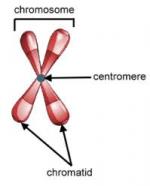|
This section contains 2,818 words (approx. 10 pages at 300 words per page) |

|
Living organisms are divided into two broad categories based upon certain attributes of cell structure. The first category, the prokaryotes, includes bacteria and blue-green algae. Eukaryotes include most other living organisms. One of the most important features distinguishing eukaryotes from prokaryotes is the chromosomal arrangement of genetic information in the cells. Eukaryotes enclose their genetic material in a specialized compartment called the nucleus. Prokaryotes lack nuclei.
Basic Organization
In 1883, Wilhelm Roux proposed that the filaments observed when cell nuclei were stained with basic dyes were the bearers of the hereditary factors. Heinrich Wilhelm Waldeyer later coined the word chromosome ("colored body") for these filaments. The eukaryotic chromosome now is defined as a discrete unit of the genome, visible only during cell division, that contains genes arranged in a linear sequence. Eukaryotic organisms contain much more genetic information than prokaryotes. For example, the eukaryotic organism Saccharomyces cerevisiae...
|
This section contains 2,818 words (approx. 10 pages at 300 words per page) |

|


